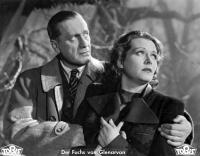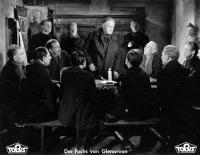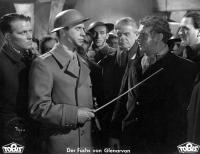Der Fuchs von Glenarvon (The Fox of Glenarvon), 1940 by Fergal Lenehan
Published in 20th-century / Contemporary History, General, Issue 6 (Nov/Dec 2011), Reviews, The Emergency, Volume 19
Irish aristocrat Baron John Ennis of Loweland (Karl Ludwig Diehl) and Gloria (Russian-born Olga Tschechowa), wife of Grandison, the local English ‘justice of the peace’, but secretly working for the rebels.
Groups of Irish nationalists, lighted torches in hand, stride forward and are joined by other Irish nationalists singing in unison about the virtues of ‘freedom’. The scene segues into black-and-white images of the sea hurtling into cliffs and the tide encroaching upon a beach, the ‘freedom’ chorus continuing. Yet the refrain is actually concerned with freiheit, the voices are singing in German and the sea that dominates the screen is in reality the Baltic Sea, not the Atlantic Ocean or the Irish Sea. Thus ends Der Fuchs von Glenarvon (The Fox of Glenarvon), an anti-British and pro-Irish Nazi propaganda film released in cinemas, to wide popular acclaim, throughout Germany in 1940. National Socialist propaganda features were often ‘historical’, and usually the history of other nations was twisted in order to serve contemporaneous purposes, legitimising new racial policies, especially anti-Semitic laws, military actions and German nationalist ideology. From 1940 onwards a small number of anti-British films were produced that raided the histories of various countries from South Africa to Ireland.

A secret meeting of ‘Ribbonmen’, who decide that they want to better the roads with the bones of their English enemies.
Max W. Kimmich, who had earlier made silent movies for Universal in Hollywood, directed The Fox of Glenarvon; he was also the brother-in-law of Nazi propaganda minister Joseph Goebbals. The film was shot in late 1939 and early 1940 and was based on a novel by a now-unknown author called Nicola Rhon. The German Baltic island of Hiddensee doubled for Ireland in external scenes, while internal scenes were shot in studio in Berlin. The Fox of Glenarvon featured some of Nazi Germany’s biggest stars. Principal among them was Russian-born Olga Tschechowa, a niece of the playwright Anton Chekov, who plays the main female role of the Irishwoman Gloria. Tschechowa mostly appeared in lighter entertainment that was often set in Habsburg Austria and in which her Slavic pronunciation of German words did not appear out of place. She vied with Zarah Leander—also, oddly enough, a non-German originally from Sweden—for the title of National Socialist cinema’s leading female star. Ferdinand Marian was cast as the devious English ‘justice of the peace’. Marian had built a career on playing ‘bad guys’ and would, six months later, star in the infamous anti-Semitic film Jud Süß. While Rhon’s novel, upon which the film is only very roughly based, was set in County Galway, the film version plays out in an unnamed Irish rural seaside area. Rebel prisoners, however, are sent to prison in Belfast, while at one stage reference is made to an atrocity occurring in a village in County Roscommon. The film-makers were definitely not overly concerned with rooting the movie in any very tangible Irish reality. The text that appears at the beginning of the film sets out the black-and-white propagandistic ‘politics’ of the piece:
‘Ireland—the Green Island—is one of the oldest victims of English violent oppression! For eight hundred years deception and falsehood, stealing, murder and arson have been the methods of British politics. Millions of starving, banished and executed people distinguish the suffering of this nation. But the pride and the love of freedom of this people cannot be broken.’
From here the audience is taken to a secret meeting of the ‘Ribbonmen’, where a group of hateful-looking Irish nationalists decide that they want to better the roads with the bones of their English enemies—definitely not the most subtle of beginnings! The Irish in the film are seen as largely poverty-stricken, staunchly nationalistic victims of dastardly, vicious yet also not particularly intelligent ‘England’. The agents of England appear chiefly as ‘Bobbies’ and nasty-looking ‘Tommies’. The message of the necessity for hate in relation to the British while the Battle of Britain waged is thus all too clear. The film is also a romantic melodrama based upon a love triangle between the English ‘justice of the peace’, Grandison, his Irish wife Gloria, who is secretly also working for the rebels, and the newly returned Irish aristocrat Baron John Ennis of Loweland (whose wife had been killed seven years previously by ‘English machine-gun fire’ during a rising). Ennis, unlike our usual image of the Irish landlord, is actually very much liked and respected in the community and is also a staunch Irish nationalist. By the end of the film Ennis and Gloria are united and Grandison, having been complicit in and directly involved in a number of devious acts, is last seen hung in a burning house, killed by the ‘Ribbonmen’.

British soldiers searching a bar for the ‘Ribbonmen’.
(All images: Deutsches Filminstitut-DIF)
Ireland as depicted in the movie is marked by nature, especially the sea, and rather tempestuous weather. The film begins and ends with standard ‘Irish’ images of wild seas crashing against rocks and cliffs, while the majority of outdoor scenes take place amid a thick fog. There is also an utterly peculiar all-male, jackbooted and strangely protracted ‘Irish dancing’ scene that appears as a rather bizarre cross between Nuremburg rally-type marching and ceilí dancing. At one stage a Mass is also viciously interrupted by distinctly evil-looking British soldiers and the church is ransacked, a scene with parallels to the 1938 ravaging and burning of synagogues throughout National Socialist Germany—parallels that a 1940 German audience may or may not, of course, have made. Yet in this instance the German audience, it was hoped, would identify themselves with the ravaged of the film, the Irish, and against the film’s ravagers, the British Army—one of the many perverse and, indeed, somewhat disturbing ironies contained in The Fox of Glenarvon. Der Fuchs von Glenarvon is available to view in the archives of the Irish Film Institute, www.irishfilm.ie. HI
Fergal Lenehan teaches at the Friedrich-Schiller-University in Jena, Germany, and is a member of the Centre for German–Irish Studies, University of Limerick.
















